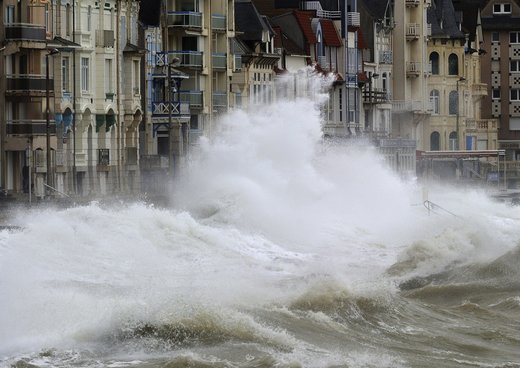31 March 2014
As the UN’s Intergovernmental Panel on Climate Change (IPCC) reports today that the impact of global warming is likely to be “severe, pervasive and irreversible”, the global reinsurance company Swiss Re has identified the 10 cities in the world most at risk of extreme weather.
Shanghai, Mumbai, New York and Amsterdam are among the cities that most need to invest in infrastructure upgrades if they are to survive the extreme weather events brought on by climate change, says global reinsurer, Swiss Re.
The most vulnerable of all to flooding and storm surges is China’s Pearl River Delta region, a densely populated area comprising Hong Kong, Shenzhen, Donguan, Macau and Guangzhou.
According to Swiss Re, the cities next most vulnerable to storm surges – the rise in water above normal tide level that occurs when hurricanes push water toward a coast – are, in order:Â
 2. Osaka-Kobe, Japan
 3. Mumbai, India
 4. Tokyo-Yokohama, Japan
 5. Amsterdam-Rotterdam, Netherlands
 6. Nagoya, Japan
 7. Shanghai, China
 8. Kolkata, India
 9. Ho Chi Minh City, Vietnam
 10. New York-Newark, USA
Storm surges exacerbate the deadly effects of hurricanes such as Hurricane Sandy, which killed 72 people in the eastern United States and caused $68bn in damage when it struck in October 2012.
Some scientists believe surges will become more frequent as a result of global warming. Last year researchers from Denmark’s University of Copenhagen suggested that for every one degree (Celsius) hike in global temperature, the frequency of large storm surges will go up two to seven times.
When ranked by vulnerability to river flooding, Swiss Re’s top 10 list changes, although the Pearl River Delta stays on top. The next most vulnerable to river floods, Swiss Re says, are:
 2. Shanghai, China
 3. Kolkata, India
 4. Jakarta, Indonesia
 5. Delhi, India
 6. Tokyo-Yokohama, Japan
 7. Bangkok, Thailand
 8. Mexico City, Mexico
 9. Cairo, Egypt
 10. Tianjin, China
Swiss Re ranked cities based on the effect natural disasters would have on its residents. The scenarios considered fatalities, injuries, evacuations, and economic impacts including work days lost.

Waves batter the sea wall at Wimereux, France on 3 January 2014. High tides and strong winds have brought flooding to areas of the UK and northern France (Philippe Huguen/AFP/Getty Images)
Other perils considered in the Swiss Re report, entitled “Mind the risk”, include tsunamis and earthquakes.
Swiss Re called for more investment in infrastructure to strengthen urban resilience because, it said, “The threat to city residents and local economies is real, and it is mounting relentlessly”.
“As an ultimate risk taker,” the company said, “the insurance industry has a vested interest in new infrastructure investments, upgrades to ageing infrastructure and adaptation measures.”
Last week Swiss Re said that total economic losses from natural and man-made disasters were $140bn in 2013, down from $196bn in 2012 and below the 10-year average of $190bn.
But it warned that the frequency of natural disasters would trend upward because of climate change.
“Rising temperatures are expected to lead to more frequent and severe extreme weather events in the future,” the company said. “If no action to reduce greenhouse gas emissions is taken, these events are likely to become an increasingly important factor in the ongoing upward trend of total losses.”
‘Pervasive and irreversible’
The risks of global warming were brought into even sharper focus today with the release of a major report by the UN’s Intergovernmental Panel on Climate Change (IPCC), which concluded that the impacts are likely to be “severe, pervasive and irreversible”.
Impacts of climate change include a higher risk of flooding and changes to crop yields and water availability, says the report, which scientists and officials convened by the IPCC in Japan last week say is the most comprehensive assessment to date.
“With high levels of warming that result from continued growth in greenhouse gas emissions, risks will be challenging to manage, and even serious, sustained investments in adaptation will face limits,” said Chris Field, co-chair of the IPCC working group that produced the report, and professor of interdisciplinary environmental studies at Stanford University.
His co-chair, Vicente Barros strove for a more positive note on the subject of adaptation strategies, which could include the construction of sea walls and levees to protect against flooding.
“We live in an era of man-made climate change,” said Barros, emeritus professor of climatology at the University of Buenos Aires. “In many cases, we are not prepared for the climate-related risks that we already face. Investments in better preparation can pay dividends both for the present and for the future.”






